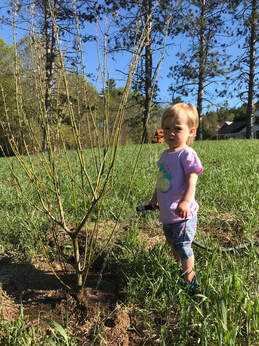 Little tree steward watering tree planted in support of wildlife connectivity. Little tree steward watering tree planted in support of wildlife connectivity. This article provides further guidance on what Valley residents can do to restore and protect biodiversity in their yards. It is a companion to the piece published January 13, 2021. The guide, a product of the Vermont Alliance for Half-Earth, is an answer to the call of biologist E.O. Wilson to preserve half of the planet for nature. The first article suggested the following strategies: Plant native species, remove nonnative invasives, reduce the size of the lawn remember that messy can be beautiful, stop using pesticides, leave the leaves and remember that dead wood is good wood. Here are additional steps to take to answer the half-yard call. Structural DiversityStructural diversity means having different three-dimensional shapes on the landscape. To increase the structural diversity, make sure to have plants of different heights, like big old trees, young trees or shrubs and herbaceous plants. If a tree falls in the woods, take the firewood, but otherwise leave it be. To increase the structural diversity, consider making a brush pile or a rock pile or dragging in some interesting logs and sticks. Mimic Old GrowthA fun way to think about creating structural diversity is trying to mimic characteristics of old growth forests. Old growth forests have big old trees and a well-developed understory, lots of standing and downed dead wood, tip up mounds and patches of young forest of different sizes and ages where wind storms created gaps. Habitat ConnectivityLarger networks of connected habitats support more species. This is because it’s easier for animals and plants to disperse through the landscape to find mates and sufficient resources. Whether in town or in the countryside, try to manage yards so the wildlife habitat within the property is connected to wildlife habitat on neighboring properties and across the road. Wetlands and Riparian BuffersIntact wetlands and riparian areas clean water, reduce flooding and support biodiversity. Naturally vegetated riparian buffers are also ideal corridors for wildlife movement because rivers and streams, stretch long distances across the landscape. View a soggy lawn as an opportunity to revegetate with wetland species and maintain or restore a buffer of native vegetation along streams and rivers. Messy is BeautifulNot everyone wants a messy yard. Here are some tips to make yards that are both aesthetically pleasing and rich in biodiversity: Use mown paths to connect areas of interest and use within the yard. Create a manicured look while using native plants. Use all the conventional landscaping techniques, like edging, designed plantings and mulching. Use the Garden Plant Finder! tool to find native ferns, flowers, shrubs, and trees of different colors and sizes. Planting flowers that bloom at different times makes for a flower bed or pocket prairie that’s pretty and good for the bees. Choose native ferns, spring ephemeral flowers and other shade-loving low plants like American wintergreen as ground covers instead of nonnatives like hostas. Rake the leaves, but spread them under nearby taller plants and into the wilder parts of the yard. Don’t deadhead flowers. Their seeds are important for winter birds, and their hollow stems are important for overwintering native bees. Try bunching them with twine or, at the very least, cutting them 8 inches off the ground. It’s okay keep some nonnative plants. It’d be hard to completely give up lilacs and apple trees. A recent study shows that breeding birds need a landscape with at least 70% native plants in order to find enough caterpillars to feed their young. Connect with the CommunityWorking towards Half- Earth, half-yard, or half-lawn for that matter, is an opportunity to support biodiversity and strengthen communities. By connecting with these community resources, people can help to support biodiversity across The Valley. Friends of the Mad River (FMR) can help through their Storm Smart program and Watershed Restoration efforts to improve flood resilience, protect clean water and foster wildlife habitat. Throughout the year, FMR works to monitor water quality, plant trees to restore riparian buffers and upland forest, steward swim holes and other community resources, and facilitates watershed-wide community discussions. The local conservation commissions play an active role in connecting local government to the conservation needs and opportunities on the ground. These commissions are often seeking volunteers. Right now, the Waitsfield Conservation Commission is seeking two new members. This article was written by Curt Lindberg with input from Friends staff and first published in the Valley Reporter on March 3rd, 2021
Comments are closed.
|
Friendsof the Mad River Archives
July 2024
Categories |
Proudly powered by Weebly

 RSS Feed
RSS Feed